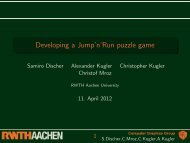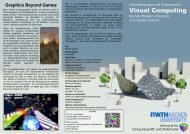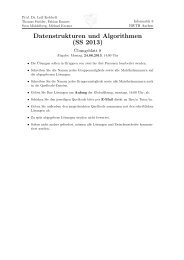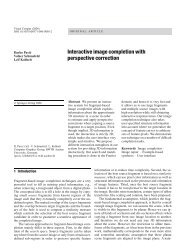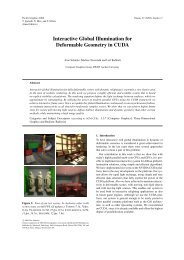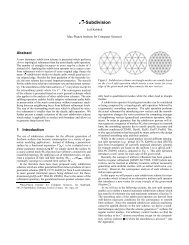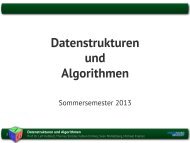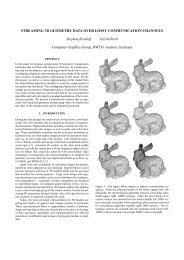Structure Preserving CAD Model Repair - OpenFlipper
Structure Preserving CAD Model Repair - OpenFlipper
Structure Preserving CAD Model Repair - OpenFlipper
Create successful ePaper yourself
Turn your PDF publications into a flip-book with our unique Google optimized e-Paper software.
EUROGRAPHICS 2005 / M. Alexa and J. Marks<br />
(Guest Editors)<br />
Volume 24 (2005), Number 3<br />
<strong>Structure</strong> <strong>Preserving</strong> <strong>CAD</strong> <strong>Model</strong> <strong>Repair</strong><br />
Stephan Bischoff<br />
Leif Kobbelt<br />
Computer Graphics Group<br />
RWTH Aachen<br />
Abstract<br />
There are two major approaches for converting a tessellated <strong>CAD</strong> model that contains inconsistencies like cracks<br />
or intersections into a manifold and closed triangle mesh. Surface oriented algorithms try to fix the inconsistencies<br />
by perturbing the input only slightly, but they often cannot handle special cases. Volumetric algorithms on the other<br />
hand produce guaranteed manifold meshes but mostly destroy the structure of the input tessellation due to global<br />
resampling. In this paper we combine the advantages of both approaches: We exploit the topological simplicity<br />
of a voxel grid to reconstruct a cleaned up surface in the vicinity of intersections and cracks, but keep the input<br />
tessellation in regions that are away from these inconsistencies. We are thus able to preserve any characteristic<br />
structure (i.e. iso-parameter or curvature lines) that might be present in the input tessellation. Our algorithm closes<br />
gaps up to a user-defined maximum diameter, resolves intersections, handles incompatible patch orientations and<br />
produces a feature-sensitive, manifold output that stays within a prescribed error-tolerance to the input model.<br />
Categories and Subject Descriptors (according to ACM CCS): I.3.5 [Computational Geometry and Object <strong>Model</strong>ing]:<br />
Curve, surface, solid, and object representations<br />
1. Introduction<br />
A common dilemma in todays CAM production environments<br />
are the different geometry representations that are employed<br />
by <strong>CAD</strong> systems on the one hand and downstream<br />
applications on the other hand. While <strong>CAD</strong> systems usually<br />
represent a model by a set of trimmed NURBS patches or by<br />
other surface primitives (that possibly are extracted from a<br />
CSG representation), downstream applications like computational<br />
fluid- or structure simulation, rapid prototyping, and<br />
numerically controlled machining rely on closed and consistent<br />
manifold triangle meshes as input. The conversion from<br />
one representation into the other is not only a major bottleneck<br />
in terms of time, but also with respect to the accuracy<br />
and quality of the output and thus directly impacts all subsequent<br />
production stages.<br />
Common tessellation algorithms are able to efficiently<br />
and accurately convert single surface primitives into triangle<br />
meshes, but usually cannot handle continuity constraints between<br />
different primitives or detect and resolve intersecting<br />
geometry. This leads to artifacts like gaps, overlaps, intersections,<br />
or inconsistent orientations between the tessellated<br />
patches, which often have to be repaired in a manual and tedious<br />
postprocessing step. For this reason, quite some effort<br />
has been put into algorithms that are able to automatically<br />
repair such models.<br />
There are two major approaches for converting a tessellated<br />
<strong>CAD</strong> model that contains inconsistencies like gaps<br />
or intersections into a clean and manifold closed triangle<br />
mesh. Surface oriented algorithms try to explicitly compute<br />
or identify consistent (sub-)patches that are subsequently<br />
stitched together by snapping boundary elements. These algorithms<br />
only minimally perturb the input patches, but due<br />
to numerical issues cannot guarantee a consistent output<br />
mesh and hence usually require user-interaction. Volumetric<br />
algorithms on the other hand use a signed distance grid as<br />
an intermediate representation and are able to produce guaranteed<br />
manifold reconstructions. Unfortunately, these algorithms<br />
destroy the structure of the input tessellation due to<br />
a global resampling stage. Furthermore the resolution of the<br />
underlying grid limits the quality of the reconstruction.<br />
In this paper we combine the advantages of both approaches:<br />
We exploit the topological simplicity of a voxel<br />
grid to reconstruct a cleaned up surface in the vicinity of<br />
intersections and cracks, but keep the input tessellation in<br />
c○ The Eurographics Association and Blackwell Publishing 2005. Published by Blackwell<br />
Publishing, 9600 Garsington Road, Oxford OX4 2DQ, UK and 350 Main Street, Malden,<br />
MA 02148, USA.
Stephan Bischoff & Leif Kobbelt / <strong>Structure</strong> <strong>Preserving</strong> <strong>CAD</strong> <strong>Model</strong> <strong>Repair</strong><br />
Figure 1: Our algorithm converts a tessellated <strong>CAD</strong> model into an intersection-free and closed triangle mesh which covers<br />
all gaps up to a prescribed size. Left: The input patches were created by tessellating a <strong>CAD</strong> model consisting of 385 trimmed<br />
NURBS surfaces. Middle: A standard volumetric reconstruction algorithm resamples the model globally and destroys any<br />
structure of the tessellation. Right: Our algorithm only resamples the model locally in regions around artifacts like gaps and<br />
intersections and thus preserves most of the input tessellation.<br />
regions that are away from these inconsistencies. We are<br />
thus able to preserve any characteristic structure (e.g. isoparameter<br />
or curvature lines) that might be present in the<br />
input tessellation. Our algorithm closes gaps up to a userdefined<br />
maximum diameter, resolves intersections and overlaps,<br />
handles incompatible patch orientations and produces<br />
a feature-sensitive, manifold output that stays within a prescribed<br />
error-tolerance to the input model.<br />
The basic idea is to first identify the critical regions containing<br />
artifacts like gaps and overlaps, then selectively applying<br />
a volumetric reconstruction algorithm in these regions<br />
and finally joining the reconstruction with the unmodified<br />
outside components. Due to its selectivity our algorithm<br />
is on the one hand able to achieve high grid resolutions and<br />
thus a high reconstruction quality near the artifacts, but on<br />
the other hand does not incur the performance overhead of<br />
algorithms that globally reconstruct the input.<br />
2. Previous Work<br />
Surface-based algorithms work directly on the input tessellation<br />
and use a number of techniques to detect and resolve<br />
artifacts. These techniques include, e.g. snapping boundary<br />
elements onto each other, projecting and inserting boundary<br />
edges into faces, explicitly computing the intersections<br />
between faces, propagating the normal field from patch to<br />
patch [BW92, BS95, BDK98, GTLH01, MD93], stitching<br />
small patches into gaps [TL94, Lie03], resolving topological<br />
noise by identifying and cutting handles [GW01], etc.<br />
Surface-based approaches only locally modify the input<br />
geometry in a small region around the artifacts. Hence, the<br />
input tessellation is preserved wherever possible. However,<br />
these approaches usually cannot give any guarantees on the<br />
quality of the output: There might be no globally consistent<br />
orientation of the input patches; certain artifacts, like overlapping<br />
geometry or “double walls” are hard to handle; intersections<br />
are difficult to detect and to resolve; due to numerical<br />
issues a robust and efficient implementation is challenging.<br />
Volume oriented approaches convert the input into a volumetric<br />
representation, i.e. a signed distance field or a grid<br />
of directed distances [NT03, Ju04, FPRJ00]. From this volumetric<br />
representation one then extracts a surface using techniques<br />
like marching cubes [LC87, KBSS01] or dual contouring<br />
[Gib98, JLSW02, Ju04].<br />
Volumetric techniques produce guaranteed manifold output.<br />
Furthermore, topological artifacts and holes can easily<br />
be removed using various filter operations on the volume<br />
[ABA02,DMGL02,NT03]. On the downside, however,<br />
the conversion to and from a volume acts as a low-pass filter<br />
that removes sharp features and leads to aliasing artifacts<br />
in the reconstruction. Furthermore, due to the global resampling,<br />
the structure of the input patches is completely destroyed<br />
and the output is usually highly over-tessellated.<br />
3. Algorithm<br />
The input to our algorithm is a tessellated <strong>CAD</strong> model<br />
M 0 = {P 1 ,...,P n} which consists of n patches P i . Each<br />
patch P i is a manifold triangle mesh and is uniquely identified<br />
by its patch ID i. Furthermore, the user prescribes an<br />
error tolerance ε 0 and a maximum gap diameter γ 0 . The output<br />
is an intersection-free and closed triangle mesh T that<br />
approximates M 0 up to a maximum error of ε 0 and covers<br />
all gaps of diameter ≤ γ 0 . Our algorithm proceeds in several<br />
stages (see Figure 2):<br />
c○ The Eurographics Association and Blackwell Publishing 2005.
Stephan Bischoff & Leif Kobbelt / <strong>Structure</strong> <strong>Preserving</strong> <strong>CAD</strong> <strong>Model</strong> <strong>Repair</strong><br />
1. Conversion of M 0 to a closed mesh M (Section 3.1)<br />
2. Identification of a set C ⊂ Z 3 of critical vertices that<br />
encloses all intersections and all gaps of diameter ≤ γ 0<br />
(Section 3.2)<br />
3. Eroding C to a minimal set C ′ (Section 3.3)<br />
4. Transforming C ′ to a set D of critical cells that covers all<br />
gaps and all intersections (Section 3.4)<br />
5. Clipping M against D (Section 3.4)<br />
6. Reconstruction of the model geometry inside D (Section<br />
3.5)<br />
7. Postprocessing to reduce the output complexity (Section<br />
3.6)<br />
1. input patches 2. critical vertices<br />
3.1. Setup<br />
In the following we assume without loss of generality that<br />
the input model is scaled and translated such that the error<br />
tolerance ε 0 = 1 and that M 0 is enclosed by an integer grid<br />
of extent<br />
[0,2 k ] × [0,2 k ] × [0,2 k ]<br />
for some k. Note that the size of the grid cells just equals the<br />
error tolerance ε 0 . We also assume that the maximum gap<br />
diameter is given as γ 0 = 2γ for some positive integer γ.<br />
We often have to associate data with a small subset of<br />
the grid vertices or the grid cells. To improve memory efficiency,<br />
this data is stored in the finest-level nodes of an octree<br />
of depth k. The octree is adaptively refined on demand,<br />
i.e. when we access a certain grid vertex or grid cell.<br />
For each patch P i ∈ M 0 we produce<br />
a mirror patch P ′ i by duplicating P i and<br />
reversing the orientation of each triangle.<br />
Then we seam P i and P ′ i along their<br />
common boundary by triangle strips S i .<br />
This yields a new and closed patch Q i<br />
that represents P i from both sides. We<br />
collect the new patches in a new model<br />
M = {Q i }. Note that M is closed, but still contains the<br />
same artifacts as M 0 . Note also that by this construction our<br />
algorithm becomes invariant with respect to the orientation<br />
of the input patches. If it turns out that the resulting “double<br />
walls” are not necessary to guarantee manifoldness of the<br />
reconstruction, they will be removed in the post-processing<br />
stage, see Section 3.6.<br />
3.2. Critical regions<br />
In the following we compute a set C γ of critical grid vertices.<br />
We think of these critical vertices as particles that fill<br />
those regions of space where two or more patches of M get<br />
closer than 2γ. These critical regions include all gaps of diameter<br />
≤ 2γ and in particular all intersections between different<br />
patches. Later stages of the algorithm will then extract<br />
the interface between critical vertices and non-critical<br />
3. critical cells 4. clipped<br />
5. prelim. reconstruction 6. result<br />
Figure 2: Stages of our algorithm. The input patches typically<br />
exhibit artifacts like gaps and intersections (1). We<br />
determine a (rather large) set of critical vertices in a local<br />
neighborhood around these artifacts (2) and then convert<br />
these vertices into a (smaller) set of critical cells (3). The input<br />
patches are clipped against the critical cells (4) and the<br />
interior of the cells is reconstructed using a variant of the<br />
Marching Cubes algorithm (5). This preliminary reconstruction<br />
is then simplified to get the final result (6). Note that the<br />
model geometry away from the artifacts is not affected by<br />
our reconstruction algorithm and hence any structure in the<br />
input patches is well preserved.<br />
vertices to create surface patches that actually close the gaps<br />
and resolve the intersections.<br />
Let us call a grid vertex v ∈ Z 3 ambiguous if<br />
Box γ(v) := {w ∈ Z 3 : ||w − v|| ∞ ≤ γ}<br />
is intersected by two or more patches of M. If v is an ambiguous<br />
vertex, we set all vertices ∈ Box γ(v) to critical, i.e.<br />
C γ :=<br />
[<br />
v ambiguous<br />
Box γ(v)<br />
Figure 3 shows some configurations of M and the corresponding<br />
ambiguous and critical vertices.<br />
Ambiguous vertices can efficiently be located by using<br />
a (temporary) octree of depth k. We shift the origin of the<br />
octree by (.5,.5,.5) T such that the centers of the finest-level<br />
c○ The Eurographics Association and Blackwell Publishing 2005.
Stephan Bischoff & Leif Kobbelt / <strong>Structure</strong> <strong>Preserving</strong> <strong>CAD</strong> <strong>Model</strong> <strong>Repair</strong><br />
octree nodes have integer coordinates, i.e. they correspond<br />
to grid vertices. If n is an octree node, we denote by c n ∈ Z 3<br />
its center and by 0 ≤ d n ≤ k its depth. Hence, if n is a finestlevel<br />
node (d n = k) we want to check whether<br />
Box(n) := Box γ(c n)<br />
is intersected by two or more different patches. Our idea is to<br />
build up a hierarchy of nested boxes which matches the octree<br />
hierarchy. Hence, if n is an interior octree node, Box(n)<br />
is chosen such that it contains the boxes of all descendants<br />
of n. A short calculation shows that this property is fulfilled<br />
by letting<br />
Box(n) := Box hn (c n),<br />
h n = 2 k−dn−1 − 1/2 + γ<br />
Note in particular, that a triangle intersecting the box of a<br />
finest-level node n will also intersect the boxes of all ancestors<br />
of n. We now recursively insert each triangle of M into<br />
the octree using an algorithm similar to that of Ju [Ju04].<br />
Starting with the root node, a triangle is inserted into a node<br />
n if it intersects Box(n). This can efficiently be tested using<br />
the separating axes theorem [GLM96]. If a node n contains<br />
triangles belonging to different patches, n is split and the triangles<br />
are distributed to its children. In the end, the center<br />
c n ∈ Z 3 of each finest-level node n that contains triangles<br />
belonging to two or more patches represents an ambiguous<br />
vertex.<br />
To increase the resolution of the critical region near M,<br />
we also compute the directed distances of each critical vertex<br />
v ∈ C γ to M by shooting rays along the coordinate axes (Figure<br />
3). Fortunately, the temporary octree we built up above<br />
already provides a spatial search structure to speed up the<br />
ray-model intersection tests. If we find an intersection within<br />
unit distance, we denote the triple (v,d,δ) consisting of the<br />
vertex v, the direction<br />
d ∈ ±{(1,0,0) T ,(0,1,0) T ,(0,0,1) T }<br />
and the distance δ ∈ [0,1] as a cut. The cuts will later be<br />
used for resampling the geometry at the points v + δd. In<br />
the figures, cuts are illustrated as small arrows attached to v<br />
and pointing in direction d, see Figure 3.<br />
3.3. Eroding C γ<br />
In the previous stage we computed a set C := C γ of critical<br />
vertices which we think of as particles that fill in all gaps of<br />
M. Later stages of the algorithm will extract the boundary<br />
of C to create surface patches that actually close these gaps<br />
and resolve the intersections. As this fill-in should alter M<br />
as little as possible, C should be as small as possible. Hence<br />
we replace C by a minimal set C ′ ⊂ C that still fills in all<br />
gaps. We get C ′ by applying a topology-preserving erosion<br />
operator on C, i.e. we successively remove critical vertices<br />
from C that are simple. (Note that we only remove critical<br />
vertices but not the cuts.) Intuitively, a vertex is called simple,<br />
if its removal does not change the topology of C, i.e. if it<br />
patch ambiguous vertex<br />
cuts critical vertex ∈ C 1<br />
Figure 3: Example configurations. Some possible configurations<br />
of patches Q ∈ M are shown above. Note that each<br />
patch is a closed triangle mesh. The critical vertices C γ fill<br />
the regions where two or more different patches of M are<br />
less than 2γ away from each other. Cuts effectively provide<br />
sub-voxel accuracy near M.<br />
does not create new connected components or handles. The<br />
exact definition of simplicity and an efficient method to determine<br />
whether a vertex is simple from its 26-neighborhood<br />
is given in [BK03]. However, we have to take into account,<br />
that in our case the cuts represent material, while in [BK03]<br />
the cuts represent empty space.<br />
We proceed as follows: For each critical vertex v, we compute<br />
its distance d(v) to the boundary of C γ. If v has a noncritical<br />
neighbor, we set d(v) = 0. The distances of the other<br />
critical vertices are computed by a distance transform on C γ<br />
that respects the cuts, i.e. distances are not propagated over<br />
a cut. We then remove ⌈2γ⌉ layers of simple critical vertices<br />
to get a new set C ′ of critical vertices (Figures 4(left) and 5):<br />
for layer=0,1,...,⌈2γ⌉ do<br />
for all vertices v with d(v)=layer do<br />
if v is simple then<br />
set v to non-critical<br />
As the following reconstruction will take place along the<br />
cuts, there should be cuts between non-critical vertices w ∉<br />
C ′ and critical vertices v ∈ C ′ . Furthermore, there should be<br />
no cuts between vertices v ∈ C ′ and M (Figures 4(right)<br />
and 5). Hence, if v is a critical vertex, we remove all cuts<br />
(v,d,δ) and instead insert cuts (w,v − w,δ smooth ) for all<br />
c○ The Eurographics Association and Blackwell Publishing 2005.
Stephan Bischoff & Leif Kobbelt / <strong>Structure</strong> <strong>Preserving</strong> <strong>CAD</strong> <strong>Model</strong> <strong>Repair</strong><br />
non-critical 6-neighbors w of v. Here, δ smooth is a special<br />
value to tell the reconstruction algorithm that w + δ smooth d<br />
corresponds to a fill-in and that the corresponding vertices<br />
should be smoothed in a postprocessing phase.<br />
Figure 4: Erosion. To the left we see the set C 2 of critical<br />
vertices that fills in a gap between two patches. The green<br />
vertices are removed by a topology-preserving erosion operation.<br />
The red vertices cannot be removed without disconnecting<br />
the two patches. Right: Each remaining (blue) vertex<br />
is replaced by cuts pointing into the vertex. All cuts now<br />
form the interface that is extracted in the later stages of the<br />
algorithm to close the gaps by surface patches.<br />
critical cell critical vertex ∈ C ′<br />
removed cuts<br />
additional cuts<br />
Figure 5: Example configurations (cont.) The topologypreserving<br />
erosion operation (Section 3.3) shrinks C γ to a<br />
smaller set C ′ which is surrounded by additional cuts. Grid<br />
cells that are adjacent to a critical vertex ∈ C ′ or that are<br />
intersected by multiple patches are marked as critical (Section<br />
3.4).<br />
3.4. Clipping<br />
In this stage we clip M against a set of critical grid cells D<br />
into an inside and an outside component such that the inside<br />
component contains all the artifacts of the model. The inside<br />
component is then discarded and replaced by a well-behaved<br />
reconstruction as described in Section 3.5.<br />
First, we need to determine the set of critical grid cells D.<br />
As D should cover all artifacts of M, i.e. all intersections<br />
and all gaps, we set a grid cell to critical,<br />
• if it contains two or more patches of M (intersection) or<br />
• if one of its incident vertices is critical (gap)<br />
Figure 5 shows some example configurations of M and their<br />
corresponding critical grid cells. In the following, we will<br />
denote a grid face as critical, if it shares an un-critical and a<br />
critical cell. A grid edge is called critical, if it is incident to<br />
a critical face.<br />
The basic idea is to split all triangles of M along the critical<br />
faces into sub-triangles such that each sub-triangle either<br />
lies completely inside or completely outside the critical region<br />
D. We then simply discard those triangles that lie completely<br />
inside.<br />
Although the mathematics of intersecting planar faces is<br />
straightforward, the actual implementation of an efficient<br />
and numerically robust clipping algorithm is a hard problem.<br />
In the following we will present a new algorithm that is<br />
specifically tailored to our setup.<br />
• At all times during the run of the algorithm the meshes<br />
stay triangle meshes. We do not have to cope with general<br />
polygons of arbitrary valence, containing holes, etc.<br />
In fact, we modify the meshes using only the Euleroperations<br />
split-1-to-3 and split-2-to-4 (edge-split) which<br />
are provided as elementary operations by most mesh libraries.<br />
• By using a mixed fixed-point/adaptive-precision representation<br />
for the vertex locations, we achieve considerable<br />
speedups without sacrifying robustness or accuracy.<br />
The clipping proceeds in three phases which are illustrated<br />
in Figure 6. In phase I we intersect the critical edges<br />
and the model faces and insert the intersection points into<br />
the model using 1-to-3 or 2-to-4 splits. In phase II we intersect<br />
the critical faces and the model edges, again inserting<br />
the intersection points using 2-to-4 splits. This process automatically<br />
produces the edges that result from intersecting<br />
a model triangle with all critical grid faces. Thus each triangle<br />
now either lies completely inside or completely outside<br />
the critical cells. In phase III we then simply discard those<br />
triangles whose center of gravity lies in a critical cell.<br />
To effectively enumerate the critical edges and critical<br />
faces, we use the recursive octree traversal technique proposed<br />
by Ju et al [JLSW02]. However, to speed up the algorithm,<br />
before descending into an octree cell, we first test<br />
c○ The Eurographics Association and Blackwell Publishing 2005.
Stephan Bischoff & Leif Kobbelt / <strong>Structure</strong> <strong>Preserving</strong> <strong>CAD</strong> <strong>Model</strong> <strong>Repair</strong><br />
whether the current triangle really intersects the cell using<br />
the separating axis theorem.<br />
successful, we calculate the real intersection point using exact<br />
arithmetics. Analogous considerations apply for triangleedge<br />
intersections, edge-edge intersections, triangle-cell intersections,<br />
etc.<br />
Initial configuration<br />
Phase I<br />
3.5. Reconstruction<br />
We now present an algorithm to reconstruct the surface in<br />
the interior of the critical cells. This algorithm uses elements<br />
of the feature–sensitive marching cubes and dual contouring<br />
algorithms that were proposed by Kobbelt et al. [KBSS01]<br />
and Ju et al. [JLSW02] and later extended by Varadhan et<br />
al. [VKK ∗ 03] to arbitrary grids of directed distances. However,<br />
in addition to being feature-sensitive, our algorithm can<br />
also handle multiple cuts per edge and seamlessly connects<br />
the reconstruction inside the critical cells to the outside geometry.<br />
Phase II<br />
Phase III<br />
Figure 6: Initial configuration: A triangle mesh is to be<br />
clipped against a set of critical grid cells. Phase I: The intersections<br />
of the grid edges with the triangles are inserted<br />
into the mesh by 1-to-3-splits or 2-to-4-splits. Phase II: The<br />
intersections of mesh edges and grid faces are inserted by<br />
2-to-4-splits. Now each triangle either lies completely inside<br />
or completely outside the set of critical grid cells. Phase III:<br />
The interior triangles are discarded.<br />
Implementation The algorithm above only works if intersections<br />
are reliably detected and correctly calculated. However,<br />
just switching to exact arithmetics will extremely slow<br />
down the algorithm. For this reason, we use a mixed representation.<br />
Let the positions of the input vertices of the model<br />
be quantized to N bits. For each vertex v, we store<br />
• its exact position p exact,v using an adaptive precision representation<br />
[Pri91, She97].<br />
• its approximate position p approx,v using a fixed point representation<br />
of N bits width<br />
such that (remember that the extent of the grid is 2 k ):<br />
||p exact,v − p approx,v|| < η := 2 k−N<br />
We can then use the approximate positions for evaluating<br />
“easy rejects” when computing intersection points. Consider<br />
for example the intersection of an edge e and a grid face<br />
f = [f min ,f max]. We first check whether e approx intersects the<br />
box<br />
[f min − (η,η,η) T ,f max + (η,η,η) T ]<br />
This test can exactly be evaluated in fixed-point arithmetics<br />
using a maximum of 3N bits only [Ju04]. Only if this test is<br />
We first enumerate all interior grid faces, again using a<br />
recursive octree traversal technique. For each interior grid<br />
face, we collect the cuts that are located on the edges of this<br />
face. Note that a grid edge might support more than two cuts,<br />
if a single patch intersects that edge multiple times. By construction,<br />
the number of cuts is always even. Furthermore,<br />
cuts pointing in clockwise (cw) direction alternate with cuts<br />
pointing in counter-clockwise (ccw) direction. We now connect<br />
these cuts by edges: a cw cut is connected to the next<br />
ccw cut by going ccw around the grid face (Figure 7, left),<br />
see also [Blo88, NH91]. If we connect two cuts from the<br />
same grid edge, we insert an auxiliary point at the face center<br />
to prevent topological degeneracies. Note that by construction,<br />
the edges do not intersect.<br />
We then visit each critical cell in turn. The edges on the<br />
cell’s faces were either created as described above or are<br />
boundary edges of the outside geometry. In any case, these<br />
edges form one or more connected loops around the cell.<br />
Each of these loops is triangulated by a triangle fan (Figure<br />
7, right). As the edges do not intersect, the loops will<br />
also be free of intersections and so are the triangle fans.<br />
Figure 7: We connect the cuts incident to a grid face by<br />
edges (left). For each grid cell these edges and the boundary<br />
edges of the outside geometry form loops around the<br />
cell. Each of these loops is triangulated by a fan of triangles<br />
(right).<br />
c○ The Eurographics Association and Blackwell Publishing 2005.
Stephan Bischoff & Leif Kobbelt / <strong>Structure</strong> <strong>Preserving</strong> <strong>CAD</strong> <strong>Model</strong> <strong>Repair</strong><br />
The position p of the fan’s center vertex is computed by<br />
minimizing the squared distances to the supporting planes of<br />
the triangles that intersect the grid cell [Lin00]. Note that, if<br />
the cell contains a feature edge or corner, this construction<br />
will place p exactly on the feature. If the computed point<br />
p happens to lie outside the cell or if it does not lie on all<br />
supporting planes, it is set to invalid. Invalid vertices are<br />
smoothed in the post-processing stage. Finally we flip the<br />
edges in interior grid faces, such that the center vertices become<br />
connected. This guarantees feature vertices in neighboring<br />
cells to be connected by a (feature) edge (Figure 8).<br />
In both cases we smooth the vertex positions by applying an<br />
iterative smoothing filter [Tau95].<br />
Decimation The output of the reconstruction algorithm is<br />
a closed and manifold triangle mesh T which approximates<br />
the input model M but has all artifacts resolved. However,<br />
T usually contains much more vertices and faces than M 0<br />
due to the artificial refinement near the gaps. This can be<br />
attributed to two effects<br />
• Every patch of the input model is represented from both<br />
sides by T .<br />
• The higher the resolution of the underlying grid, the more<br />
triangles are needed for reconstructing the model in the<br />
critical regions.<br />
Accordingly, we have two options for reducing the output<br />
complexity. First, the mesh T usually consists of multiple<br />
connected components, only few of which really contribute<br />
to the outside of M. The other components merely triangulate<br />
M from the inside and hence can be easily identified<br />
and discarded. The identification can be done manually or<br />
automatically by a flood fill process as in [Ju04]. Second,<br />
we apply a standard feature-sensitive mesh decimation algorithm<br />
to T [GH97]. However, to preserve the input tessellation<br />
of M, we only do this in regions that were reconstructed<br />
anyway.<br />
4. Results<br />
sampled vertex<br />
smoothed vertex<br />
Figure 8: Example configurations (cont.) The geometry in<br />
the critical grid cells is replaced by a reconstructed surface<br />
R which is extracted from the cuts using a variant of the<br />
Marching Cubes algorithm. Some of the vertices of R can<br />
directly be sampled from M. Others, however, correspond<br />
to those parts of R that cover the gaps of M. The position of<br />
these vertices is determined by an iterative smoothing filter.<br />
3.6. Postprocessing<br />
Smoothing After the reconstruction stage the positions of<br />
the following types of vertices is not yet determined.<br />
• Vertices that correspond to those parts of the reconstruction<br />
that span gaps of M and hence have no canonical position.<br />
These are the vertices that either are derived from<br />
cuts (v,d,δ smooth ) or are the centers of triangle fans that<br />
are created in an empty grid cell.<br />
• Vertices that are the centers of triangle fans in grid cells<br />
that contain conflicting geometry — usually due to an insufficient<br />
refinement depth k.<br />
We have evaluated our method on a number of <strong>CAD</strong> models<br />
of different complexities (Figures 9, 10, 11). All timings<br />
were taken on a 2GB, 3.2 GHz Pentium 4 computer.<br />
Choice of input parameters As our algorithm only reconstructs<br />
the regions around artifacts and as this local reconstruction<br />
is further decimated in the postprocessing phase,<br />
the output complexity grows typically only sub-linearly with<br />
respect to the grid resolution. Hence we can use high grid<br />
resolutions to improve the reconstruction quality without incuring<br />
an undue overhead of generated triangles. If the tessellation<br />
of the input patches is sufficiently accurate, we can<br />
set γ = 1 without missing any gaps even for high resolutions.<br />
Asymptotic behaviour If the artifacts form a one dimensional<br />
subspace e.g. along the intersection of two surfaces<br />
or along two abutting patches, the number of critical vertices<br />
and cells should in theory grow linearly with respect to<br />
the grid resolution for a constant γ. Our experimental results<br />
match well with this theoretical statement, only the Camera<br />
model (Figure 10) is an exception because it contains a lot<br />
of interior geometry and “double walls”. These artifacts cannot<br />
suffiently be resolved and hence the critical vertices and<br />
cells actually form a two or three-dimensional subspace. In<br />
these regions the octree has to be refined to maximum depth,<br />
which causes a significant increase in memory usage.<br />
c○ The Eurographics Association and Blackwell Publishing 2005.
Stephan Bischoff & Leif Kobbelt / <strong>Structure</strong> <strong>Preserving</strong> <strong>CAD</strong> <strong>Model</strong> <strong>Repair</strong><br />
Helicopter, 10 k triangles in 60 patches, γ = 1<br />
resolution 1024 3 2048 3 4096 3 8192 3<br />
#critical vertices 242 k 505 k 1037 k 2079 k<br />
#critical cells 68 k 141 k 277 k 561 k<br />
#output triangles 28 k 34 k 44 k 60 k<br />
time 47 s 116 s 291 s 868 s<br />
Camera, 19 k triangles in 83 patches, γ = 1<br />
resolution 128 3 256 3 512 3<br />
#critical vertices 192 k 655 k 1978 k<br />
#critical cells 83 k 270 k 874 k<br />
#output triangles 33 k 61 k 81 k<br />
time 56 s 145 s 639 s<br />
Figure 10: Camera<br />
Figure 9: Helicopter<br />
5. Discussion<br />
We have presented a new and efficient algorithm for fully<br />
automatic and selective repair of tessellated <strong>CAD</strong> models.<br />
However, a number of issues are still open for future work.<br />
Artifacts within a single patch Our algorithm does reliably<br />
detect and resolve artifacts between different patches.<br />
However, it does not resolve artifacts within a single patch,<br />
like e.g. self-intersections. Of course, we could extend our<br />
algorithm to also handle such artifacts, but that would significantly<br />
decrease its performance. The reason is, that during<br />
the construction of the vertex octree, we often have to check<br />
whether a certain box contains two or more patches. Currently<br />
this check is very fast, as we only have to compare the<br />
patch IDs of the participating triangles. However, if we also<br />
wanted to detect self-intersections within a single patch, we<br />
would actually have to intersect each triangle with all other<br />
triangles in the box. This can be done very fast [SAUK04]<br />
but as none of our models has self-intersecting patches, we<br />
conclude that such a situation does not happen very often in<br />
practice. If it does, the user has to manually divide the patch<br />
into non-self-intersecting subpatches.<br />
Selectivity Our algorithm does only modify critical regions<br />
of the model, i.e. regions containing intersections or gaps,<br />
and preserves the structure of the tessellation everywhere<br />
else. These critical regions are determined fully automatically<br />
from a global user-defined parameter γ 0 . It should,<br />
however, be possible to let this parameter locally depend on<br />
the underlying model geometry such as to close gaps of different<br />
sizes. It should also be possible to apply one of the<br />
surface oriented mesh repair algorithms in a preprocessing<br />
step to segment the input into large and manifold patches<br />
wherever possible and apply our method only to those regions<br />
where the surface oriented methods fail.<br />
Reconstruction We reconstruct the surface in the critical<br />
regions from a grid of directed distances using a novel<br />
contouring algorithm. This algorithm correctly resolves any<br />
self-intersections based on the local configuration of the cuts<br />
around a grid face only. However, other (possibly global)<br />
criteria might also be incorporated. For example, we might<br />
strive for a reconstruction of minimal genus or of minimal<br />
number of connected components. For a standard grid of<br />
signed distances and the Marching Cubes algorithm, this has<br />
already been explored by Andujar et al. [ABC ∗ 04].<br />
Space and time efficiency Due to its selectivity, our algorithm<br />
already proved to be quite space and time efficient.<br />
In our implementation we have used standard libraries for<br />
the octree and mesh data structures and for the exact arithmetic<br />
and the mesh decimation framework. We believe that<br />
we could achieve considerable speed ups and lower memory<br />
usage if we used custom-tailored data structures and algorithms<br />
instead. As our algorithm operates on local information<br />
only, it should also be easily possible to generalize it to<br />
parallel machines.<br />
c○ The Eurographics Association and Blackwell Publishing 2005.
Stephan Bischoff & Leif Kobbelt / <strong>Structure</strong> <strong>Preserving</strong> <strong>CAD</strong> <strong>Model</strong> <strong>Repair</strong><br />
Ventilator, 269 k triangles in 12 patches, γ = 2<br />
resolution 1024 3 2048 3 4096 3 8192 3<br />
#critical vertices 238 k 460 k 828 k 1649 k<br />
#critical cells 64 k 113 k 229 k 523 k<br />
#output triangles 503 k 512 k 529 k 556 k<br />
time 83 s 123 s 193 s 303 s<br />
References<br />
Figure 11: Ventilator<br />
[ABA02] ANDUJAR C., BRUNET P., AYALA D.:<br />
Topology-reducing surface simplification using a discrete<br />
solid representation. ACM Trans. Graph. 21, 2 (2002),<br />
88–105.<br />
[ABC ∗ 04] ANDUJAR C., BRUNET P., CHICA A.,<br />
NAVAZO I., ROSSIGNAC J., VINACUA A.: Optimizing<br />
the topological and combinatorial complexity of isosurfaces.<br />
Computer-Aided Design to appear (2004).<br />
[BDK98] BAREQUET G., DUNCAN C., KUMAR S.:<br />
RSVP: A geometric toolkit for controlled repair of solid<br />
models. IEEE Trans. on Visualization and Computer<br />
Graphics 4, 2 (1998), 162–177.<br />
[BK03] BISCHOFF S., KOBBELT L.: Sub-voxel topology<br />
control for level-set surfaces. Computer Graphics Forum<br />
22, 3 (September 2003), 273–280.<br />
[Blo88] BLOOMENTHAL J.: Polygonization of implicit<br />
surfaces. Computer Aided Geometric Design 5, 4 (1988),<br />
341–355.<br />
[BS95] BAREQUET G., SHARIR M.: Filling gaps in the<br />
boundary of a polyhedron. Computer-Aided Geometric<br />
Design 12, 2 (1995), 207–229.<br />
[BW92] BØHN J. H., WOZNY M. J.: Automatic <strong>CAD</strong><br />
model repair: Shell-closure. In Proc. Symp. on Solid<br />
Freeform Fabrication (1992), pp. 86–94.<br />
[DMGL02] DAVIS J., MARSCHNER S., GARR M.,<br />
LEVOY M.: Filling holes in complex surfaces using volumetric<br />
diffusion. In Proc. International Symposium on<br />
3D Data Processing, Visualization, Transmission (2002),<br />
pp. 428–438.<br />
[FPRJ00] FRISKEN S. F., PERRY R. N., ROCKWOOD<br />
A. P., JONES T. R.: Adaptively sampled distance fields:<br />
A general representation of shape for computer graphics.<br />
In Proc. SIGGRAPH 00 (2000), pp. 249–254.<br />
[GH97] GARLAND M., HECKBERT P. S.: Surface simplification<br />
using quadric error metrics. In Proc. SIGGRAPH<br />
97 (1997), pp. 209–216.<br />
[Gib98] GIBSON S. F. F.: Using distance maps for accurate<br />
surface representation in sampled volumes. In Proc.<br />
IEEE Symposium on Volume Visualization (1998), pp. 23–<br />
30.<br />
[GLM96] GOTTSCHALK S., LIN M. C., MANOCHA D.:<br />
OBBTree: a hierarchical structure for rapid interference<br />
detection. In Proc. SIGGRAPH 96 (1996), pp. 171–180.<br />
[GTLH01] GUÉZIEC A., TAUBIN G., LAZARUS F.,<br />
HORN B.: Cutting and stitching: Converting sets of polygons<br />
to manifold surfaces. IEEE Transactions on Visualization<br />
and Computer Graphics 7, 2 (2001), 136–151.<br />
[GW01] GUSKOV I., WOOD Z. J.: Topological noise removal.<br />
In Proc. Graphics Interface 2001 (2001), pp. 19–<br />
26.<br />
[JLSW02] JU T., LOSASSO F., SCHAEFER S., WARREN<br />
J.: Dual contouring of hermite data. In Proc. SIGGRAPH<br />
02 (2002), pp. 339–346.<br />
[Ju04] JU T.: Robust repair of polygonal models. In Proc.<br />
SIGGRAPH 04 (2004), pp. 888–895.<br />
[KBSS01] KOBBELT L. P., BOTSCH M., SCHWANECKE<br />
U., SEIDEL H.-P.: Feature sensitive surface extraction<br />
from volume data. In Proc. SIGGRAPH 01 (2001),<br />
pp. 57–66.<br />
[LC87] LORENSEN W. E., CLINE H. E.: Marching cubes:<br />
A high resolution 3D surface construction algorithm. In<br />
Proc. SIGGRAPH 87 (1987), pp. 163–169.<br />
[Lie03] LIEPA P.: Filling holes in meshes. In Proc. Symposium<br />
on Geometry Processing 03 (2003), pp. 200–205.<br />
[Lin00] LINDSTROM P.: Out-of-core simplification of<br />
large polygonal models. In Proc. SIGGRAPH 02 (2000),<br />
pp. 259–262.<br />
[MD93] MÄKELÄ I., DOLENC A.: Some efficient procedures<br />
for correcting triangulated models. In Solid<br />
Freeform Fabrication Symposium Proceedings (1993),<br />
pp. 126–134.<br />
[NH91] NIELSON G. M., HAMANN B.: The asymptotic<br />
decider: resolving the ambiguity in marching cubes. In<br />
c○ The Eurographics Association and Blackwell Publishing 2005.
Stephan Bischoff & Leif Kobbelt / <strong>Structure</strong> <strong>Preserving</strong> <strong>CAD</strong> <strong>Model</strong> <strong>Repair</strong><br />
VIS ’91: Proceedings of the 2nd conference on Visualization<br />
’91 (1991), pp. 83–91.<br />
[NT03] NOORUDDIN F., TURK G.: Simplification<br />
and repair of polygonal models using volumetric techniques.<br />
IEEE Transactions on Visualization and Computer<br />
Graphics 9, 2 (2003), 191–205.<br />
[Pri91] PRIEST D. M.: Algorithms for arbitrary precision<br />
floating point arithmetic. In Tenth Symposium on Computer<br />
arithmetic (1991), pp. 132–143.<br />
[SAUK04] SHIUE L.-J., ALLIEZ P., URSU R., KETTNER<br />
L.: A Tutorial on CGAL Polyhedron for Subdivision Algorithms.<br />
Tech. rep., 2004.<br />
[She97] SHEWCHUK J. R.: Adaptive precision floatingpoint<br />
arithmetic and fast robust geometric predicates. Discrete<br />
& Computational Geometry 18 (1997), 305–363.<br />
[Tau95] TAUBIN G.: A signal processing approach to fair<br />
surface design. In Proc. SIGGRAPH 95 (1995), pp. 351–<br />
358.<br />
[TL94] TURK G., LEVOY M.: Zippered polygon meshes<br />
from range images. In Proc. SIGGRAPH 94 (1994),<br />
pp. 311–318.<br />
[VKK ∗ 03] VARADHAN G., KRISHNAN S., KIM Y., DIG-<br />
GAVI S., MANOCHA D.: Efficient max-norm distance<br />
computation and reliable voxelization. In Proc. Symposium<br />
on Geometry Processing (2003), pp. 116–126.<br />
c○ The Eurographics Association and Blackwell Publishing 2005.



